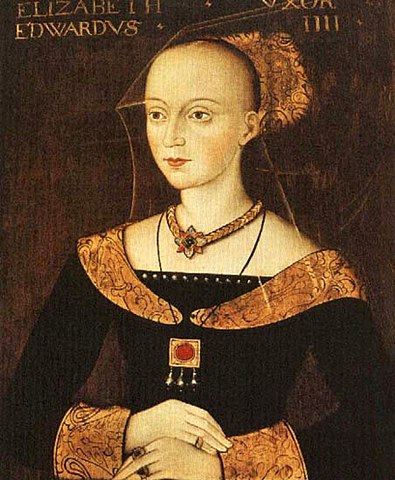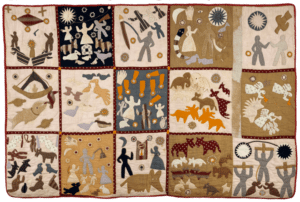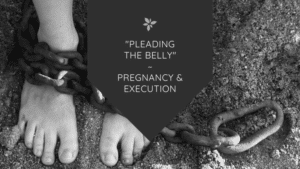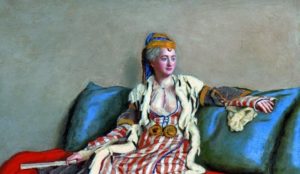In the 1400s Britain was embroiled in a civil war known as the Cousins War, or the Wars of the Roses. Most people remember the Kings and the many battles… but behind the scenes Elizabeth Woodville was always there, pulling strings to keep her children from harm and to bring them to greatness. With every turn she faced betrayal and danger as England’s White Queen.

At around 1436 Jacquetta Woodville, wife to the Earl of Rivers, gave birth to a daughter named Elizabeth. Jacquetta was from the royal house of Burgundy and was close allies with King Henry VI and his wife Margaret of Anjou. She was a determined woman who wanted to make sure that her children had a powerful future ahead of them. When her daughter Elizabeth, the first of 14 children, was old enough she was sent to live with Lady Grey to learn how to become a lady and manage her own household.
In 1452 when Elizabeth was 15 she was married to the Grey’s oldest son, John. A year after the wedding Elizabeth gave birth to a son named Thomas, and then to her second son Richard in 1457. Despite the happy start to Sir John and Elizabeth’s marriage it would not last long. The country was at war with the Lancastrians (the reds) and the Yorks (the whites) fighting against each other for the crown. Both the Woodville family and the Greys were on the side of the Lancastrians—the reds.
In the battle of St Albans in 1461 there was a white victory, where Elizabeth’s father and brother had to plead for a pardon for the new King Edward IV. But her husband Sir John had died in battle. The Yorks took away Elizabeth’s dower lands, leaving her sons with no inheritance, and Elizabeth was forced to move back to the family home in Grafton.

Elizabeth was determined and strong willed—she was not going down without a fight. In early 1464 Elizabeth went out with her sons and sat under an oak tree she knew the King would pass. When he did, Elizabeth stopped him and pleaded to have her lands back. The King was enchanted by Elizabeth’s beauty, and became besotted with her.
In their negotiations to regain Elizabeth’s land, Elizabeth refused to become the King’s mistress. But King Edward was passionate about Elizabeth so he proposed. Elizabeth, also in love with Edward, accepted. Edward and Elizabeth married in 1464 not long after they first met, but it was not a grand occasion. In fact, the only people in attendance were a priest, Elizabeth’s mother Jacquetta, and two ladies maids; no one else knew the marriage had taken place. It was only when Edward’s closest advisor, Lord Warwick, suggested a proposal he had made with a French Princess that it was revealed Edward was married. Elizabeth was crowned 26 May 1465 as Queen of England.
The marriage was not well perceived by many. One person who hated the marriage was the King’s mother, who hated Elizabeth as she was a Lancastrian commoner and not of her choosing. Lord Warwick also despised the marriage, having been publicly embarrassed when he had sought out a marriage contract on behalf of the French princess and was was then told that the King was already married. He also felt betrayed by the King as he thought Edward had complete loyalty to him after Lord Warwick made Edward king.
Rumors started to circulate about the new Queen. Elizabeth was a direct descendant of house of Luxemburg. It was said that Melusina, a water goddess, married Elizabeth’s ancestor Count Siegfried, and that their female descendants had magic powers. The people whispered that Elizabeth had cast a spell on Edward to make him fall in love with her.
Despite all the controversy, Elizabeth’s marriage to Edward was going well, and they were happy together. However, Elizabeth had borne three daughters. Although all were alive and healthy, they needed a son to be heir. So when Elizabeth became pregnant for a fourth time, she was praying for a boy.
Meanwhile, Lord Warwick had resurfaced after a time away from court, trying to oust Edward by allying with the Lancastrian forces. The Lancastrians were winning, and Edward was forced to flee abroad, leaving a heavily pregnant Elizabeth in London. Elizabeth fled with her children to Westminster Abbey. It was there in sanctuary that Elizabeth gave birth to a son, who she named Edward after his father.
In 1470, Edward returned to quash the Lancastrian forces, killing Warwick in battle. The Lancastrian King and and Queen were captured and King Henry VI was murdered in the Tower of London.
Elizabeth and Edward’s rule was happy from then on, until King Edward died suddenly of pneumonia in April 1483. The new King Edward was young and so his father’s brother Richard was placed as Lord Protector. Richard feared the Elizabeth’s family would seize power, so he arrested Elizabeth’s brother, Anthony, and her son Richard Grey. He then placed the new King in the Tower of London. Elizabeth, fearing for her family’s safety, sought sanctuary with her remaining children.
Richard, crowning himself King Richard III, started to become paranoid that Elizabeth wanted to destroy him. He declared Elizabeth’s sons illegitimate, hiding them away in the Tower of London where they were never seen again. Richard then secured his throne by executing Elizabeth’s brother, Anthony Woodville, and her younger son Richard Grey.
Elizabeth was furious when she heard of the executions. She immediately entered into an alliance with Margaret Beaufort, the mother to the only Lancastrian heir Henry Tudor. They agreed that Elizabeth would help get Henry on the throne if Henry would marry Elizabeth’s eldest daughter, Elizabeth of York.
In 1485, Henry Tudor invaded England and defeated Richard III in battle. He was soon crowned King Henry VII, and the infamous Tudor dynasty was born. Henry married Elizabeth’s daughter as promised, and Elizabeth was given her full title and honours back. In 1487 Elizabeth retired to life in an Abbey. Elizabeth managed to live to see the Tudor line secured through the rule of two of her descendants before her death in April 1492.
Elizabeth Woodville was a key figure in British history. Every tactful move Elizabeth made affected the outcome of the Wars of the Roses. She is a pivotal person, but one who is often forgotten about.
Next, read about Queen Anna of Denmark, Theater Pioneer & Patron of the Arts, or Queen Liliʻuokalani, first and last queen regnant of Hawaii!
Abbie McDonough blogs at Women From Our Past. You can follow her on twitter as @historicwomen.





There are so many women in history overlooked, especially Elizabeth Woodville.
I a direct decent to Elizabeth Woodville on my father’s side. I never knew why the tudor family and plantagenet family was so interesting to me until I did my ancestry. Allot of this I already knew.
Totally agree. Men seem to try and sort things out by battles but women looked ahead, could see how different outcomes would affect them and their families and work behind the scenes to make sure things worked out the best for them, their families and who they wanted on the throne
Elizabeth was, and is, the fairest maid of all…
Slight error in the history here, Edward was a boy of 13 who accompanied his father the duke of York at the first battle of St. Albans in 1455. The second battle of St. Albans in February 1461, the Yorkists troops were led by the earl of Warwick, and the duke of Norfolk. The Yorkists lost the battle, and Edward was involved in the battle of mortimers cross in Herefordshire 200 miles away., so a little hard to see how he spared Elizabeth woodvilles family when he wasn’t even present at the battle?..
Edward was crowned king of England on his way with his family to America, in Somerset, by the bishop of York(Merlin), who had the lead royal seal of Edward 4th, and left , on the wind, without navigation, to Labrador, through the port of Appledore, and settled in Iowa, USA, with the cooperation of the American first nation, where Elizabeth carried, with her, the French translation of the bible, from the original Greek, before it was translated into English in the 17th century. WHERE IS IT NOW??? It is leather bound, in buck skin, and surrounded by deer antler horn, and was brought to England by the Duke of Monmouth, to prove his ancestry, but was rejected by James 2nd, so he returned with his mother, Lucy Walters, through France to America, in 1685.
oh wow
This is exactly like the show The White Queen on STARZ.
I agree saw this several times
How did she live to see the Tudor line secured through the rule of two of her descendants? Unless you mean she lived long enough to see her future descendant who would be heirs to throne born as Henry Viii did not become King until 1509 and when Elizabeth died in 1492, Prince Arthur was still alive.
I THINK she may mean that she seen her 1st son become king ( before he was declared to young and Richard took over as king) and then the 2nd time was when her daughter married the new king Henry and had a child….i may be completely wrong but thats what I took from reading it
She lived see the birth of Arthur and Henry I believe
Wonderful article! She is my 14th Great Grandmother & I’m very proud to be descended from her.
Margaret, Beaufort was the Most determined woman Determined to see her son become Henry the seventh, sometimes I wish that had not happened because then we wouldn’t have had the tyrant King his son Henry the eighth, he brought about the reformation and misery that caused also a break up with Ireland which was largely Catholic.